Page 5 of 162
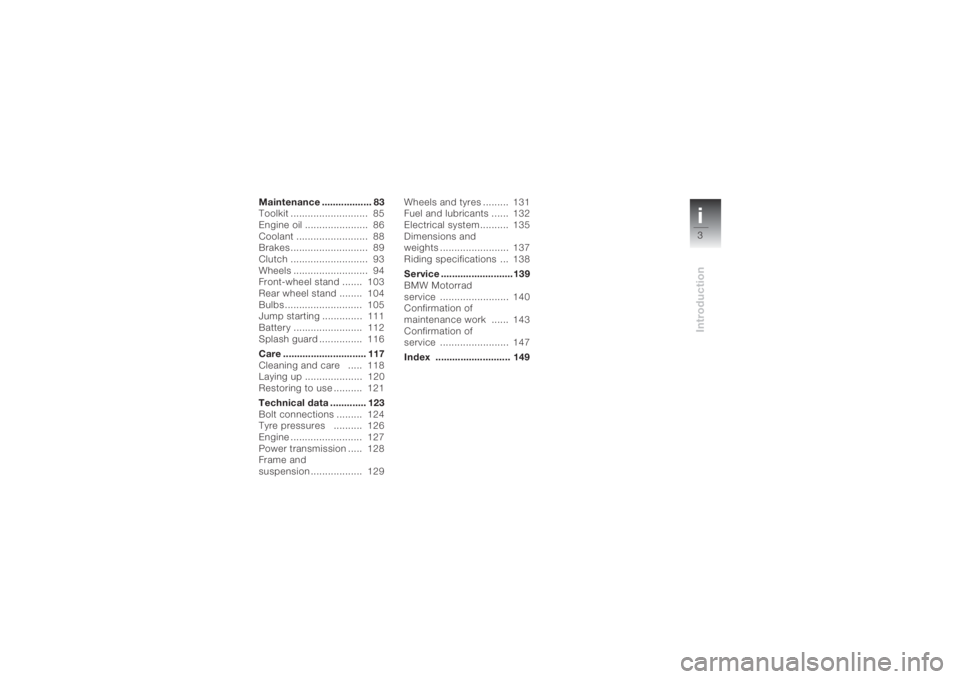
i3Introduction
Maintenance .................. 83
Toolkit ........................... 85
Engine oil ...................... 86
Coolant ......................... 88
Brakes ........................... 89
Clutch ........................... 93
Wheels .......................... 94
Front-wheel stand ....... 103
Rear wheel stand ........ 104
Bulbs ........................... 105
Jump starting .............. 111
Battery ........................ 112
Splash guard ............... 116
Care .............................. 117
Cleaning and care ..... 118
Laying up .................... 120
Restoring to use .......... 121
Technical data ............. 123
Bolt connections ......... 124
Tyre pressures .......... 126
Engine ......................... 127
Power transmission ..... 128
Frame and
suspension .................. 129Wheels and tyres ......... 131
Fuel and lubricants ...... 132
Electrical system.......... 135
Dimensions and
weights ........................ 137
Riding specifications ... 138
Service .......................... 139
BMW Motorrad
service ........................ 140
Confirmation of
maintenance work ...... 143
Confirmation of
service ........................ 147
Index ........................... 149
Page 7 of 162
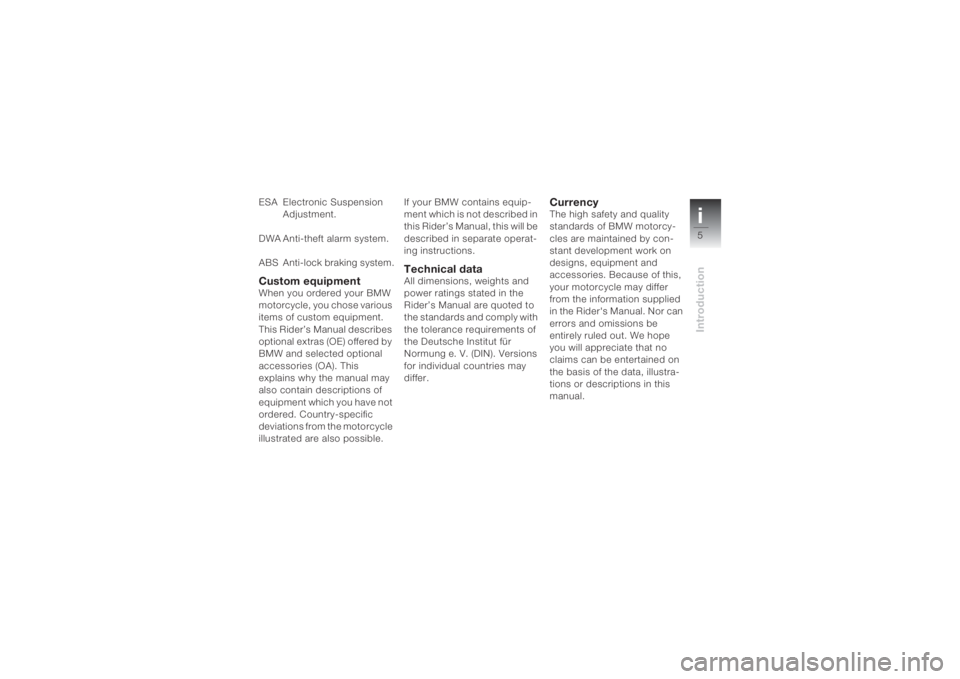
i5Introduction
ESA Electronic Suspension
Adjustment.
DWA Anti-theft alarm system.
ABS Anti-lock braking system.Custom equipmentWhen you ordered your BMW
motorcycle, you chose various
items of custom equipment.
This Rider’s Manual describes
optional extras (OE) offered by
BMW and selected optional
accessories (OA). This
explains why the manual may
also contain descriptions of
equipment which you have not
ordered. Country-specific
deviations from the motorcycle
illustrated are also possible.If your BMW contains equip-
ment which is not described in
this Rider’s Manual, this will be
described in separate operat-
ing instructions.
Technical dataAll dimensions, weights and
power ratings stated in the
Rider’s Manual are quoted to
the standards and comply with
the tolerance requirements of
the Deutsche Institut für
Normung e. V. (DIN). Versions
for individual countries may
differ.
CurrencyThe high safety and quality
standards of BMW motorcy-
cles are maintained by con-
stant development work on
designs, equipment and
accessories. Because of this,
your motorcycle may differ
from the information supplied
in the Rider's Manual. Nor can
errors and omissions be
entirely ruled out. We hope
you will appreciate that no
claims can be entertained on
the basis of the data, illustra-
tions or descriptions in this
manual.
Page 45 of 162
343Operation
To make the loops accessible:
• Remove the seat and turn it
around.
• Pull loops1 out of retaining
brackets3.
• Turn the seat around and
refit.
MirrorsAdjusting mirrors• Move the mirrors into the
desired position by pressing
lightly on one of the corners.Spring preloadAdjusting spring preload
on the rear wheel
Adjusting the spring
preload while the motor-
cycle is being ridden can lead
to accidents.Adjust the spring preload
only when the motorcycle is
stationary.c
The spring preload must be
adapted to the load of the
motorcycle. An increase in the
load requires an increase in
the spring preload; less weight
requires a correspondingly
lower spring preload.
• Place the motorcycle on the
centre stand
OA or side
stand, ensuring that the
ground is firm and level.
Page 52 of 162
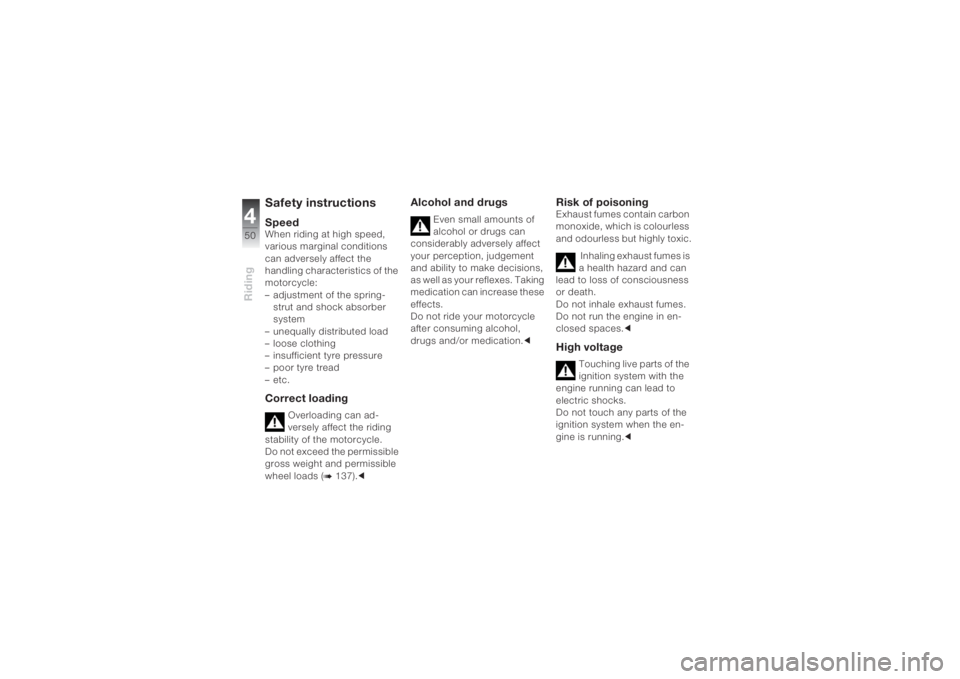
Riding450
Safety instructionsSpeedWhen riding at high speed,
various marginal conditions
can adversely affect the
handling characteristics of the
motorcycle:
– adjustment of the spring-
strut and shock absorber
system
– unequally distributed load
– loose clothing
– insufficient tyre pressure
– poor tyre tread
–etc.Correct loading
Overloading can ad-
versely affect the riding
stability of the motorcycle.
Do not exceed the permissible
gross weight and permissible
wheel loads (
b 137).c
Alcohol and drugs
Even small amounts of
alcohol or drugs can
considerably adversely affect
your perception, judgement
and ability to make decisions,
as well as your reflexes. Taking
medication can increase these
effects.
Do not ride your motorcycle
after consuming alcohol,
drugs and/or medication.c
Risk of poisoningExhaust fumes contain carbon
monoxide, which is colourless
and odourless but highly toxic.
Inhaling exhaust fumes is
a health hazard and can
lead to loss of consciousness
or death.
Do not inhale exhaust fumes.
Do not run the engine in en-
closed spaces.cHigh voltage
Touching live parts of the
ignition system with the
engine running can lead to
electric shocks.
Do not touch any parts of the
ignition system when the en-
gine is running.c
Page 54 of 162
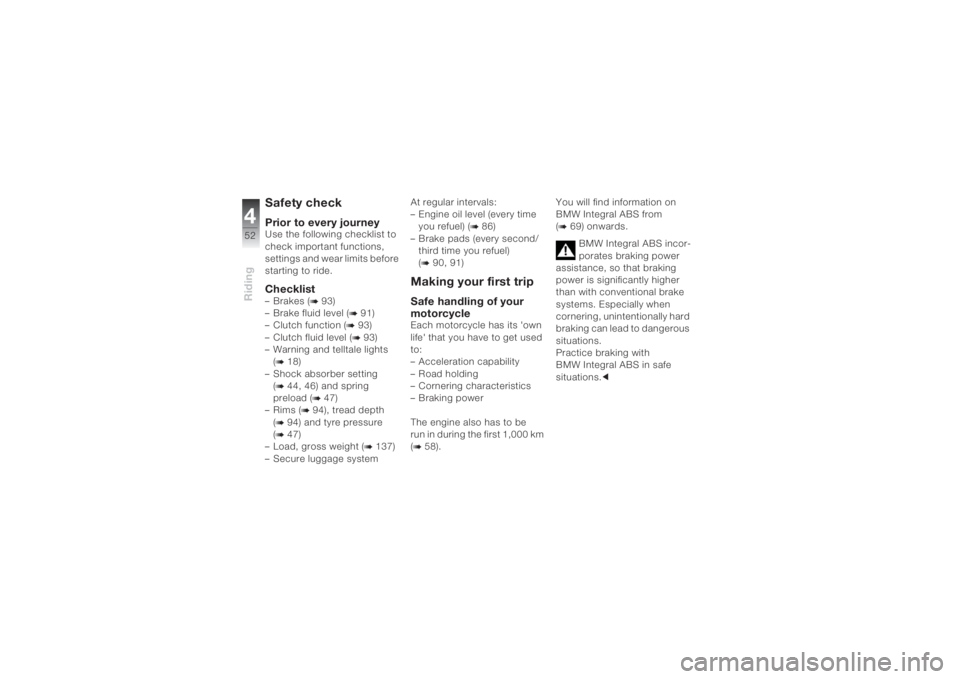
Riding452
Safety checkPrior to every journeyUse the following checklist to
check important functions,
settings and wear limits before
starting to ride. Checklist–Brakes (
b 93)
– Brake fluid level (
b 91)
– Clutch function (b 93)
– Clutch fluid level (b 93)
– Warning and telltale lights
(
b 18)
– Shock absorber setting
(b 44, 46) and spring
preload (
b 47)
–Rims (
b 94), tread depth
(
b 94) and tyre pressure
(b 47)
– Load, gross weight (
b 137)
– Secure luggage systemAt regular intervals:
– Engine oil level (every time
you refuel) (
b 86)
– Brake pads (every second/
third time you refuel)
(
b 90, 91)
Making your first tripSafe handling of your
motorcycleEach motorcycle has its 'own
life' that you have to get used
to:
– Acceleration capability
– Road holding
– Cornering characteristics
–Braking power
The engine also has to be
run in during the first 1,000 km
(b 58).You will find information on
BMW Integral ABS from
(
b 69) onwards.
BMW Integral ABS incor-
porates braking power
assistance, so that braking
power is significantly higher
than with conventional brake
systems. Especially when
cornering, unintentionally hard
braking can lead to dangerous
situations.
Practice braking with
BMW Integral ABS in safe
situations.c
Page 63 of 162
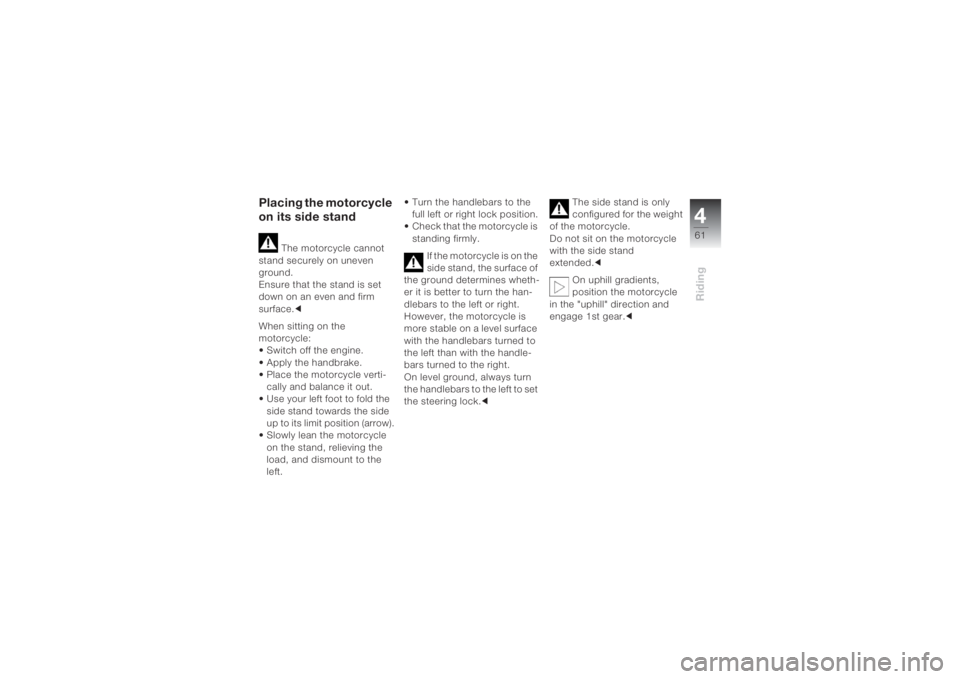
461Riding
Placing the motorcycle
on its side stand
The motorcycle cannot
stand securely on uneven
ground.
Ensure that the stand is set
down on an even and firm
surface.c
When sitting on the
motorcycle:
• Switch off the engine.
• Apply the handbrake.
• Place the motorcycle verti-
cally and balance it out.
• Use your left foot to fold the
side stand towards the side
up to its limit position (arrow).
• Slowly lean the motorcycle
on the stand, relieving the
load, and dismount to the
left.• Turn the handlebars to the
full left or right lock position.
• Check that the motorcycle is
standing firmly.
If the motorcycle is on the
side stand, the surface of
the ground determines wheth-
er it is better to turn the han-
dlebars to the left or right.
However, the motorcycle is
more stable on a level surface
with the handlebars turned to
the left than with the handle-
bars turned to the right.
On level ground, always turn
the handlebars to the left to set
the steering lock.cThe side stand is only
configured for the weight
of the motorcycle.
Do not sit on the motorcycle
with the side stand
extended.c
On uphill gradients,
position the motorcycle
in the "uphill" direction and
engage 1st gear.c
Page 67 of 162
465Riding
Placing the motorcycle
on the centre stand
OA
The motorcycle cannot
stand securely on poor
ground.
Ensure that the stand is set
down on a firm and even
surface.c
• Switch off the engine.
• Dismount, keeping your left
hand on the handlebar grip.
• With your right hand, take
hold of the pillion passenger
grab handle or rear frame.
• Place your right foot on the
actuating pin of the centre
stand and press the centre
stand downwards until the
rolling feet make contact
with the ground.• Place your full body weight
on the centre stand and at
the same time pull the
motorcycle backwards
(arrow).
• Check that the motorcycle is
standing firmly.
The centre stand can fold
in if there is excessive
motion and lead to the vehicle
falling over.
Do not sit on the motorcycle
with the centre stand
extended.c
Page 72 of 162
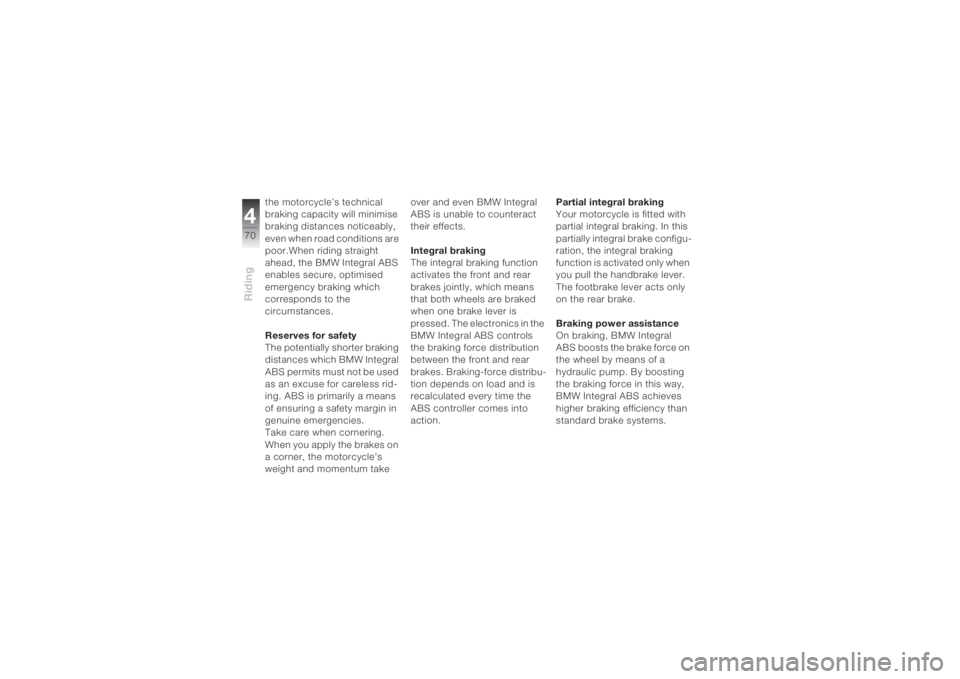
Riding470
the motorcycle’s technical
braking capacity will minimise
braking distances noticeably,
even when road conditions are
poor.When riding straight
ahead, the BMW Integral ABS
enables secure, optimised
emergency braking which
corresponds to the
circumstances.
Reserves for safety
The potentially shorter braking
distances which BMW Integral
ABS permits must not be used
as an excuse for careless rid-
ing. ABS is primarily a means
of ensuring a safety margin in
genuine emergencies.
Take care when cornering.
When you apply the brakes on
a corner, the motorcycle’s
weight and momentum take over and even BMW Integral
ABS is unable to counteract
their effects.
Integral braking
The integral braking function
activates the front and rear
brakes jointly, which means
that both wheels are braked
when one brake lever is
pressed. The electronics in the
BMW Integral ABS controls
the braking force distribution
between the front and rear
brakes. Braking-force distribu-
tion depends on load and is
recalculated every time the
ABS controller comes into
action. Partial integral braking
Your motorcycle is fitted with
partial integral braking. In this
partially integral brake configu-
ration, the integral braking
function is activated only when
you pull the handbrake lever.
The footbrake lever acts only
on the rear brake.
Braking power assistance
On braking, BMW Integral
ABS boosts the brake force on
the wheel by means of a
hydraulic pump. By boosting
the braking force in this way,
BMW Integral ABS achieves
higher braking efficiency than
standard brake systems.